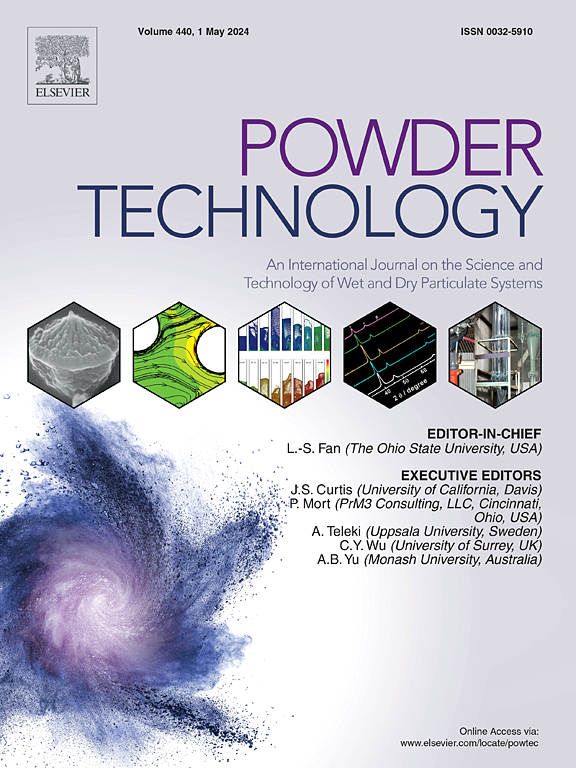A quantitative, image-based analysis of the spreading performance of PolyArylEtherKetone polymer powders during Powder Bed Fusion Additive Manufacture
IF 4.5
2区 工程技术
Q2 ENGINEERING, CHEMICAL
引用次数: 0
Abstract
Powder spreadability in the powder bed fusion process is normally visually assessed by the machine operator through repeat trials at room temperature or elevated temperatures. Some studies used powder rheology results as an indicator of the powder spreadability. This study presents a novel method of image-based analysis for the assessment of polymer spreading quality for powder bed fusion and demonstrates that the subjective assessment of the machine operator can be replaced by quantitative and measurable data. Twenty-four developmental grade PolyArylEtherKetone powders were tested. Images of the powder bed surface were analysed in MATLAB and the relationships with the powder rheology established through statistical analysis. The two methods for calculating surface deviations from variations in the greyscale images showed to be sensitive to the recoater travel and presented a strong correlation with the Normalised Aeration Sensitivity (NAS), a powder rheology parameter identified in a previous study as the most significant parameter able to categorise powder flow and spreadability based on a yes/no response.

基于图像的聚芳基醚酮聚合物粉末在粉末床熔融添加剂制造过程中的铺展性能定量分析
粉末床融合工艺中的粉末铺展性通常由机器操作员在室温或高温下通过重复试验进行目测评估。一些研究使用粉末流变学结果作为粉末铺展性的指标。本研究提出了一种基于图像分析的新方法,用于评估粉末床熔融过程中聚合物的铺展质量,并证明机器操作员的主观评估可以被量化和可测量的数据所取代。对二十四种开发级聚芳基醚酮粉末进行了测试。用 MATLAB 分析了粉末床表面的图像,并通过统计分析确定了与粉末流变学的关系。根据灰度图像中的变化计算表面偏差的两种方法均显示出对重涂机行程的敏感性,并且与归一化曝气灵敏度(NAS)有很强的相关性,NAS 是之前研究中确定的粉末流变参数,是能够根据 "是"/"否 "反应对粉末流动性和铺展性进行分类的最重要参数。
本文章由计算机程序翻译,如有差异,请以英文原文为准。
求助全文
约1分钟内获得全文
求助全文
来源期刊

Powder Technology
工程技术-工程:化工
CiteScore
9.90
自引率
15.40%
发文量
1047
审稿时长
46 days
期刊介绍:
Powder Technology is an International Journal on the Science and Technology of Wet and Dry Particulate Systems. Powder Technology publishes papers on all aspects of the formation of particles and their characterisation and on the study of systems containing particulate solids. No limitation is imposed on the size of the particles, which may range from nanometre scale, as in pigments or aerosols, to that of mined or quarried materials. The following list of topics is not intended to be comprehensive, but rather to indicate typical subjects which fall within the scope of the journal's interests:
Formation and synthesis of particles by precipitation and other methods.
Modification of particles by agglomeration, coating, comminution and attrition.
Characterisation of the size, shape, surface area, pore structure and strength of particles and agglomerates (including the origins and effects of inter particle forces).
Packing, failure, flow and permeability of assemblies of particles.
Particle-particle interactions and suspension rheology.
Handling and processing operations such as slurry flow, fluidization, pneumatic conveying.
Interactions between particles and their environment, including delivery of particulate products to the body.
Applications of particle technology in production of pharmaceuticals, chemicals, foods, pigments, structural, and functional materials and in environmental and energy related matters.
For materials-oriented contributions we are looking for articles revealing the effect of particle/powder characteristics (size, morphology and composition, in that order) on material performance or functionality and, ideally, comparison to any industrial standard.
 求助内容:
求助内容: 应助结果提醒方式:
应助结果提醒方式:


